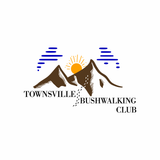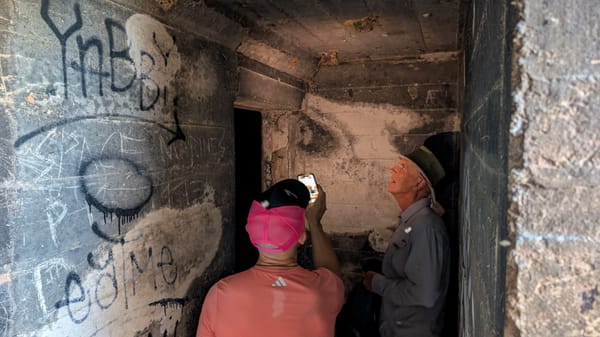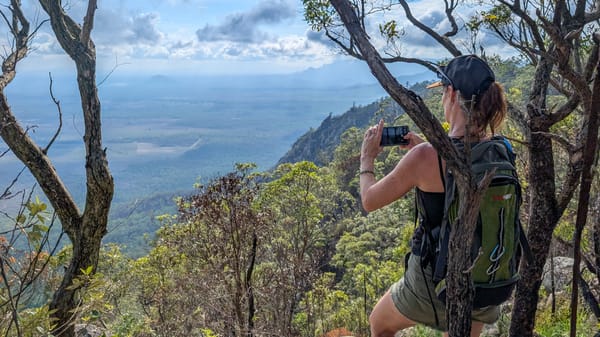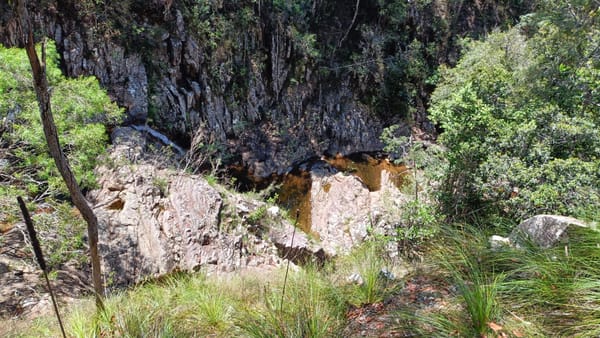TNFC Newsletter - May 1981
Explore the Townsville N.F.C. Bushwalkers May 1981 newsletter: upcoming walks to Paradise Bay, Bishop’s Peak, Herbert River, Saddle Mountain & Murray Falls; meeting dates; beginner essentials; bush meals; trip reports (Routeburn Track, Mt Spec); Upper Broadwater Creek history in North Queensland.
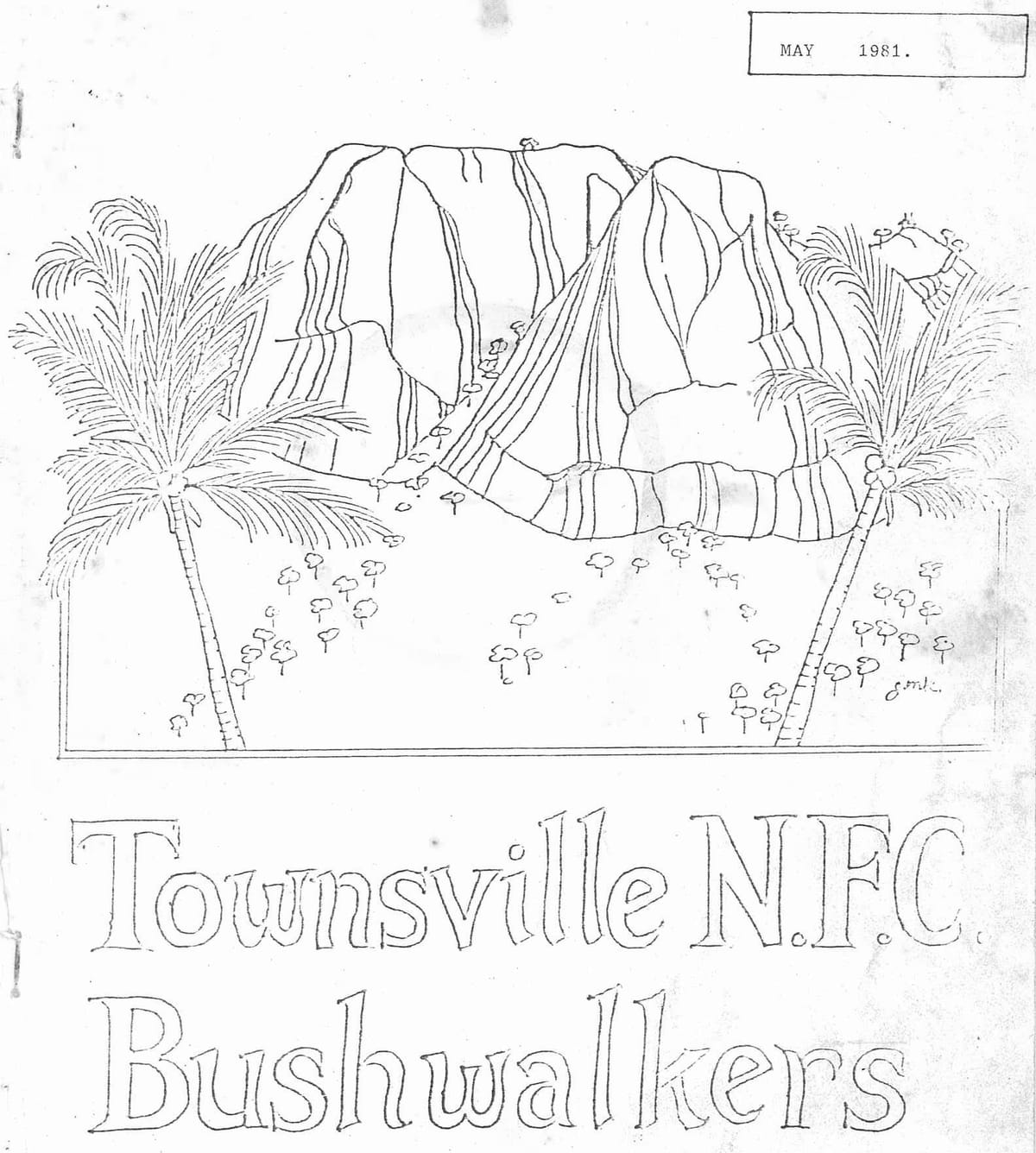
TOWNSVILLE N.F.C. BUSHWALKERS CLUB. MAY 1981.
P.O.Box 494,
TOWNSVILLE,
Qld . 4810.
Hon. Officers:
President Allan Watson
Vice President Roy Williams
Secretary Lily Marcellos
Treasurer Pauline Roberts
Equipment officer Bill Dunstan
Safety Training Officer -
Editors Les & Lynn Hyland
Contacts:
Karmen Nisbet,
10,Nobel Street, WULGURU,
Qld 4811
Ph: 781935
Adrian Jeffries
Townsville Environment Centre,
819,Flinders Street,
Townsville, Qld. 4810
Ph: 716226.
xxxxxxxxxxxxxxxxxxxxxxxxxxxxxxxxxxxxxxxxxxxxxxxxxxxxxxxxxxxxxx
Forthcoming Programme:
May 2,3,4, Shay's Clearing via Waterfall Creek Helmut Bock D $3.80
May 17 Paradise Bay Allan Watson E $3.00
May 31 Bishop's Peak Les Hyland M $6.20
June 6,7,8. Herbert River T.B.A. M $13.00
June 14 Saddle Mountain Lou Darveniza M $3.00
June 27,28 Murray Falls T.B.A. H $8.50
Meeting Dates:
MAY 13, 27 JUNE 10, 24. JULY 8, 22 (All Wednesdays) at 20.00 hrs
AT: Townsville Environment Centre, (Next to the Pizza Sorrento) Flinders St.
Townsville.
Details of meeting place and requirements for each walk are arranged at
the meeting immediately preceeding each walk. It is therefore most
essential that participants attend the meeting in question.
EDITORIAL.
Sitting on the bank of a creek with an umbrella tree's penumbra flickering on the sun-drenched pool below one is, perhaps, permitted idle reflections. Why do we go bushwalking ? I suppose one could arrive at as many answers as bushwalkers of whom the question is asked but common to many of these will be the three that most readily spring to mind. First, in a world where so many of us are in sedentary employment, will be the cry that bushwalking is an ideal way of exercising and few of us, returning from a hard walk, will fail to feel the pleasurable feeling of exhaustion. Some of us will remember walks where the going was tough(Do I hear Conway or Ethel Creek mentioned ?) where utter exhaustion seemed a better description and the adjective "pleasurable" might have been regarded by some at the time as a decided overstatement. Secondly, there is a real feeling of achievement in getting out in the bush - the challenge of making your way to the top of a peak, up a creek or of finding an old-time track. The third answer will surely be the attraction of the countryside, for who will deny that we Townsville Bushwalkers have seen magnificent places never visited by the general public and that the outstanding falls, scenery and swimming places in our area are well off the beaten track. All these are valid reasons.
But how many of us will think of the fourth reason - the friendly fellowship of other kindred spirits - which is, probably, as strong a motivation as any of the other three. I recall Kate Fulton, after every walk saying "niver agin", in her unmistakable Scots accent but she, invariably, had her name on the next trip sheet, and still, from far off Edinburgh, has maintained contact with friends in our Club. Some have found something deeper than just friendship ; Rick & Lee Williams, Andy & Liz Plunkett, Darryl & Chris Wright all met each other while walking with us and, indeed, I myself met Lynn in just the same way.
When I first came to join the Townsville Bushwalkers I was impressed above all by the friendly welcome having , as a stranger to Townsville, had different experiences in other non-bushwalking clubs. First impressions are important. Let us therefore be jealous of our reputation in this regard. Let us all make sure we are never too busy to talk to, encourage or help others and most especially the newcomer to our ranks.
LES HYLAND
-o-o-o-o-o-o-o-o-o-o-
ESSENTIALS FOR THE BEGINNER .
Lexine Schaper.
- A fine Day.
- Ample "Dencorub" for before & after walk
- Sympathetic friends to apply above.
- 1 packt "RadoX" for each swimming hole on the trip.
- Barley Sugar - I wouldn't have got back without it.
- Rubber(not glass) soles.
- An easy walk - not a rock scramble.
- Muscles trained for the Olympics.
- Reliable supply of hot water for return bath.
(Check NORQEB trade relations beforehand - A sense of Humour.
BOOK REVIEW. 100 WALKS IN NTH. QLD.
by Brian Hackness.
Hill of Content. Melb.
Based on the unavailability of this publication shortly after release earlier this year, I was expecting great things. However having now laid eyes upon it, it' easy to see why it was scarce - all the non-walkers had purchased it.
The title suggests it contains details on 100 walks, two of them up Castle Hill, another along the Strand etc. These are classed by the author, Brian Hackness, as easy, half day walks covering some 3-4 km. Magnetic Island gets 3 or 4 mentions, including Mt. Cook - one day, hard. Probably correct!
The Nth. Qld. walks, cover areas ranging from Rockhampton to Cairns and as far west as Porcupine Gorge, Hughenden. However most are confined to coastal regions and islands.
On the local scene, conspicuous by their absence, is any reference to the Mt. Elliot and Bartle Frere walks. Although the standard used throughout the book is certainly not up to a jog up Bartle Frere, one would have expected Mt. Elliot National Park to rate. Which immediately takes me onto the next aspect ie. National Parks.
The author, naturally had to limit recommended walks to public areas, which, if we had to be satisfied with, would probably mean a pretty boring programme. The Townsville Bushwalkers are very fortunate to have access through private property, a privilege we must all respect.
Given the above limitation, Brian Hackness, has put together a collection of very suitable walks for the visitor to Nth. Qld. and its release coincided very conveniently with the arrival of International Flight to Townsville. Pity it's unobtainable or was during February.
In short, it is not for us, but, would certainly recommend it to anyone, interested enough to see some of the beautiful spots of Nth. Qld., who is not serious enough to join a Bushwalking Club.
G.W.S. T'VILLE N.F.C.
BUSHWALKERS.
-o-o-o-o-o-o-o-o-o-
GOURMET BUSH MEALS
Lynn Hyland
Ever tried ? - Foil wrapped garlic steak,with foil wrapped spuds,pumpkin and boiled zucchini
- Maccaroni special : small tin braised steak, onions and capsicum fried, 1 pkt tomato paste,garlic & herbs. 1 pkt parmesan cheese and cooked macaroni.
- Rosemary Lamb chops : fry chops with powdered oregano & garlic, stir fry onion with mushrooms - serve with boiled spud chokoe and carotts.
- Chilli con Carne : small tin braised steak,onion & capsicum fried, small tin 3 bean mix, chilli powder, 2 pkts tomato paste and cooked rice.
Dessert - Got the idea? you too can be a gourmet meal planner.
By the way! - Who says that cooking for two is any harder than for one ? Finally, draw lots for the dishes.
UPPER BROADWATER CREEK
Allan Watson.
A brief outline of the discovery of gold in North Queensland is given to show the timing of the exploration of the Upper Broadwater Creek Area.
Cardwell was founded in January 1864 and by the end of April the Dalrymple Track was established. Gold was first discovered in North Queensland on the Star River - some 50 miles inland from Townsville - in November 1865. Over the next four years diggings were established at the Cape River,Ravenswood, Charters Towers, the Gilbert and the Etheridge. In 1873, gold was discovered on the Palmer River by James Venture Mulligan, while the Hodgkinson goldfield was practically deserted by 1883.
In the winter of 1886, George Clarke, Willie Joss and Christie Palmerstone prospected the headwaters of the inhospitable but beautiful Russell River and a small payable goldfield was worked. It was around 1905 that A.W.Blackman finally ventured into the rugged Upper Broadwater Creek area in search of gold, it was not,however, untill 1936 or 1937 that the small Bartle Frere goldfield, between the North and South Mulgrave Rivers and the North and South Johnstone Rivers was discovered.
A.W. Blackman traversed the country between Five Mile Creek and the junction of Tin and Broadwater Creeks and obtained fair prospects of alluvial tin in the area.He then followed the latter creek down through a gorge in the Rockingham Bay Range to the flat country. Around 1928 W.Shipman prospected creeks in the locality. During 1935 Francis and Blackman followed Broadwater Creek from the southern side of the Rockingham Bay Range, Northwards through the gorge and traversed the country as far north as the head of Kennedy Creek. The following year, with Five Mile Creek as a base, Broadwater Creek, Shipman's Creek, Five Mile Creek and others were prospected resulting in the discovery of payable alluvial tin on 16th November 1939. The tin ore in the area was fairly uniform fine grained with occasional coarse pieces and consisted of black, grey, amber, ruby and wood varieties. Traces of gold and, in some creeks, wolfram was associated with the cassiterite.
D.Francis, T.Creagh and F.Jenkin located a track from Cardwell to Upper Broadwater Creek and applied to the Mines Department for a grant of £200 to enable them to complete a pack track from Cardwell to the workings. Work was commenced on 10th.November 1939 but the track was obliterated by the cyclone of of 18th February 1940 and was not finished untill the 14th April 1940.Pack animals were then used to convey supplies although there were steep, stony and slippery grades where animals had difficulty in finding a foothold. The following slopes were recorded on the climb up the range:-
20/24 degrees for 8½ chains 21 degrees for 11 chains
17 degrees for 12 chains 18 degrees for 16 chains
These grades were not considered excessive in themselves. Zig-zagging was considered necessary to reduce the grade for better footholds and a further grant of £90 was applied for - this amount was the wages for three men for six weeks.
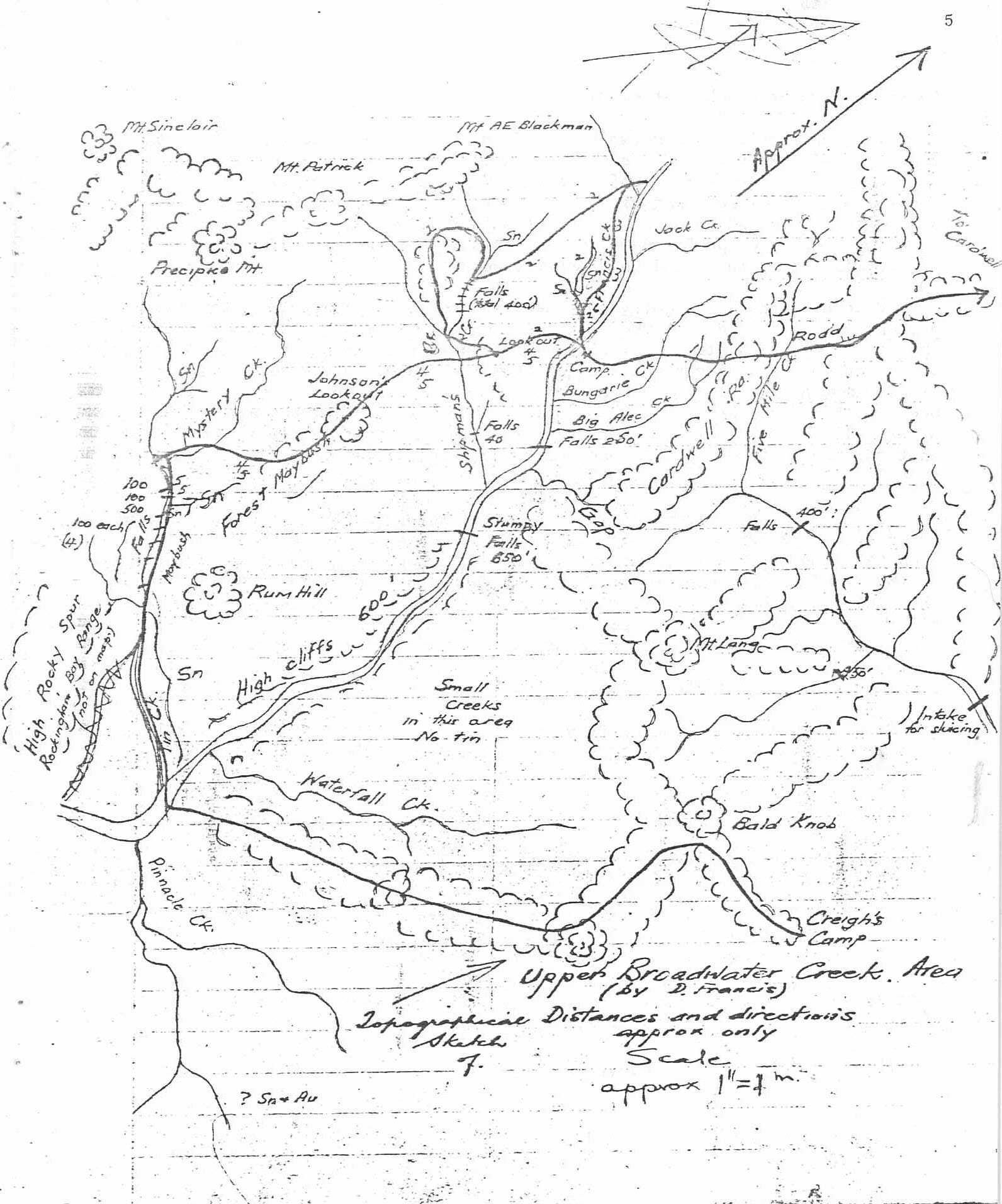
The map overleaf was drawn by David Francis in 1940 and his remarkable knowledge of the area is evident. He himself considered he had a working knowledge of 15 square miles of this rugged area and his advice to visitors was to suggest a light swag with waterproof cover, a pair of well-fitting hob nailed boots and an oiled shirt. He said that the leeches were bad but there were no other pests. He also mentioned that there was a further 250 square miles of unknown and unprospected country.
I doubt that this country has been explored in any detail even to the present time. Some idea of the ruggedness of the terrain can be imagined from the following description: " Tin Creek is the largest tributary of Broadwater Creek and runs S.E. for about 4 miles from the claim. In its upper reaches it is comparatively flat, then a series of seven falls totalling some 1100 ft occur within a further mile, below which the creek runs through a gorge with steep walls for approximately one mile to join the Broadwater Creek". Note that the modern topographical maps mark the original Tin Creek as Shipman's Creek.
In October 1977 Graeme Wells, myself and another travelled up Broadwater Creek from Abergowrie for a day and a half to reach the junction of Tin Creek (Now Shipmans Creek). This involved swimming through narrow deep waterholes on the second day without a pack. Note, however, that the main gorge is above this point and should be interesting indeed. D Francis shows 600 ft high cliffs on one side of the gorge. The next year Graeme, myself and another travelled downstream on Broadwater Creek from the "Workings" area to reach falls that we considered 250 ft high. From the old map it is evident that we did not reach the main falls further downstream, shown as 650 ft high.
I hope to lead a small party on a through walk from Upper Broadwater Creek to the flat country taking several days and, hopefully, with time to enjoy the surroundings of this superb creek.
-0-0-0-0-0-0-
Extended Trip - Car Hints.
- Leave a large bottle of water in the coolest part of your parked car.
- Place a bundle of fresh clothes in the car for the return journey.
- An emergency meal pack left in the car on long trips is a good idea in case of a delay or a late start back home.
- Even if you don't carry a large powerful torch, it is a good idea to leave such a torch in the car when a trip is expected to be a long one or an exploratory one. That extra light source is a great bonus upon return to vehicles in the dark.
-0-0-0-0-0-0-0-
THE ROUTEBURN TRACK - NEW ZEALAND.
Glennis Lee.
It was a fine Tuesday afternoon in January as we set off from the Divide ( Te Anau side of the Routeburn Track ) After 1½ hours of trudging uphill and resting, we arrived at the Lake Howden Hut, to be greeted by an aloof atmosphere emitted by the occupants. Apparently, we were the 22nd. and 23rd. to arrive at the 20 bunk hut, and we weren't the last that night. Needless to say, not much sleep was had by all, but Allan and I made up for that at Lake Mc.Kenzie the following day. Sandflies were out in swarms that night, ready to devour anyone who ventured beyond the hut. In addition, the commune - style living of hut life took some assimilation and I was glad it would only be temporary.
The stretch from Lake Howden to Lake Mc. Kenzie only took about 3½ hours; just in time for lunch. The hut was bustling with activity and most of the bunks had already been taken, but we managed to secure a bunk each.
After emerging from our nap we decided to explore the surroundings as it would be light to 10 o'clock. The sight of sunbaking bodies seemed reminiscent of the Gold Coast - a real tourist venture. We bumped into four people we'd met at different stages of our New Zealand trip - just happened to be on the same mountain.
Some hardy people ( obviously hailing from somewhere near the North Pole ), ventured in for a dip in the lake. A walk in up to my knees resolved my activities to lying in the sun listening to the educational pursuits of Americans.
Later that evening as everyone milled about the hut, our attention was demanded by a rather bureaucratic Warden issuing duties to everyone, collecting hut fees and listing rules and regulations. ( My mind flashed back to books I'd read about Boarding Schools. ) Is this really the way people escape civilization and see the real mountain countryside? My mind flashed back again to the typical campsite I was used to - a blazing fire, a relaxed atmosphere and the knowledge that you were the only ones there.
The next day dawned beautiful and fine, so we packed our heavy boots, jeans and woollen jumpers, and donned shorts, short sleeved shirts and joggers. ( We had come prepared for the worst, having heard several experiences of rain, wind, cold and blizzards.)
We left the hut at 8:00. The track was quite dry compared to the mud and water we'd run into before Lake Mc. Kenzie. The mountainside was covered in wildflowers and for a while we had them to ourselves and our cameras had a field day. However this peace was short lived and we found ourselves continually greeting people.
The scenery on the Harris Saddle was a photographers dream. We spent some time sitting above Lake Harris taking it all in. From here it was mostly downhill. We set off to catch up with the Minister and his three children with whom we had a chance of a lift to Queenstown, if we were at the end of the track when they emerged. We met them at the Routeburn Falls Hut and in order to secure a lift, moved on.
The track henceforth was a monotonous stretch - about 3½ hours of it ! Rests were few and far between, but we pressed onwards as the children were hot on our heels.
Finally, 8 hours after our start that morning, and all ready to trade in our feet for a new pair, we sighted the suspension bridge, signifying the end of our trek. Appropriately, we collapsed on the grass under a tree, and pondered on the past few days. Despite the " touristiness" of the track, it had been an enjoyable experience. It had been a long day, and was by no means at an end. Little did we suspect what was in store for us in Queenstown .......but that's another story.
-0-0-0-0-0-0-0-
REMINISCENCES OF THE TABLELANDS TO OUR NORTH.
Warren Harley.
I have for years wandered the mountains west of Atherton. One of the places I found most intriguing was the Oakey Creek valley, a tributary of the Walsh River. This creek is situated on the opposite side of the Mountain Range, west of Atherton. It is accessible by road, or it can be approached via Mt. Baldy, a well known treeless summit.
Oakey Creek is a permanent running creek with small waterholes, thus making it unsuitable for swimming. There are three large waterfalls in close proximity to each other, known as the Walsh Falls. The base of these Falls are accessible from the western side only, due to cliffs on the eastern side of the gorge. The Falls are approximately 80 feet high. Wildlife is quite often seen along the creek eg. birds, lizards and black snakes being common.
The creek eventually leaves the gorge and travels through a very wide flat valley, meeting the Walsh River to the west.
For the adventurous walker, a three day return trip to Springmount Weir can be a challenge. This Weir is situated west of Atherton on the opposite side of the Range and is constructed across the Walsh River.
It is a difficult walk through mountainous, waterless terrain. The best route is via the Hog Hill Spur, which takes the walker around the northern edge of the mountains.
Other walks in the area are quite interesting, but few surpass the view obtainable from the summit of Mt. Baldy, overlooking the Atherton Tablelands.
-0-0-0-0-0-0-0-
THE MOUNT SPEC TRACKS REVISITED
Lou Darveniza
It was a good bushwalking trip. We walked-in along an old timber track which crossed Mt Spec, thence down to Gard's battery and along Bullocksy Tom's track to Johnstone's Clearing where we camped the night. Next day we retraced our steps to the vicinity of Gard's battery, followed Foxlee's Track out to Foxlee's lookout, returned from the lookout and followed a small creek down to Shay's Clearing where our second camp was made. Next day we walked out from Shay's to our car and returned to Townsville.
It was fascinating to compare Marion's and my own reactions to a good bushwalk with those of the children: Alister - seven, and Ben - Four and three quarters.
Our trip included an element of sentiment. Memories from some fourteen years ago when Marion and I first crossed this way came flooding back. The romance of those long forgotten miners, their mule tracks, their mining, their lives, was still there. The sheer pleasure of spending some time isolated in the thick, cool,and unspoiled rainforest with its crystal clear creeks was with us. Of course, there was the element of adventure in learning of the route over Mt. Spec and getting down to Shay's.
For the children, the greatest of pleasures were all the brand new sounds and sights. The beautiful scrup python on the track - two of Dad, four of Ben, do they eat people? No, but in South America there are snakes big enough to cat people, etc. etc. Then there were the four nasty and agressive scrub-black snakes which we met on the tracks. The weird noises of the cat-birds and all the other rainforest birds, mornings and evenings were greeted with delight. Of course, there were scrub-turkeys, scrub hens, black cockatoos and so on. Foxlee's Lookout was "not much of a lookout" and Gard's Battery was "not a good place to camp". The creek leading down to Shay's became Chewbacca's Creek and echoed to the sounds of Star Wars. There was the usual fascination with camp fires and the adult sized appetites of little people.
For different reasons we all enjoyed the experience. There was truth in the impromptu refrain - we will all be back to Foxlee's Track.
-o-o-o-o-o-o-o-
T-SHIRT TIME AGAIN!
Shirts, plus $1.00 to be in the hands of
Lynn Hyland, 82, Cook St, North Ward
On or before WEDNESDAY 27th MAY 1981 - a meeting night.
This is the last printing to our distinctive design for 1981.
The Club has in stock one size 16 and one size 18 ready printed.
Cost $ 5.00 per shirt
Don't miss out; next printing will not be before early 1982.
FIRE
by Harry Kershaw.
The raging wind howls and makes horizontal spillikins of the chilling rain. Though we know they are there, no rocky phalanxes of mountain appear through the dense grey shrouds. This is Summer in Tasmania and our favourite song is "Why are we waiting?"
The dictionary gives "Fire, n. state of burning,combustion,flame,glow, oxygenation", and, even though it has been with man for aeons, our scientists are still unsure of what it really is:(I think that any bushwalker,picking up the wrong end of a burning stick could supply them with a very expletive answer.) We actually owe animal life itself to a low-key type of fire - the oxygenation that gives us body heat. Real fire, in its many forms, has been with our ancestors since time immemorial. It is surprising to know that the Australian Aborigine is recently credited to be the first pre-historic race to use controlled fire i.e: cooking and hunting. I remember my mother saying that fire is a good servant but a bad master - chopping wood and making the house fire was one of my early domestic delights.
We all know the role fire has played in the industry of man, from the first smelting of metals to the searing brands that send men into space but what we are concerned with here is the bushwalkers' fire. I think we can all plead guilty to the joy of seeing a small wisp of grey smoke turning into a "good servant" who will boil the billy or create the light and warmth to tell yarns around the camp fire. But I hope we will not plead the same to construct a "bad master", a terrible djinn that can cause havoc and destruction to life and property. No, our Club Members always dowse their fires before they leave.
As a corollary to fire destruction the biggest blaze I ever saw was in the May "Blitz" of Liverpool in World War II. In a city area c devastation we firemen scurried around with pumps to supply a turntable ladder. "Water on!" Back went the signal to the pumps,but instead of a great gush of water,a small trickle came from the top of the ladder. The water mains had been bombed so all that we could do was watch the light well of Goodlass Wall's paint warehouse turn into a huge bunsen burner, shooting flame hundreds of feet into the sky. Not too close, for dozens of meteoric turps, oil and paint tins whizzed from the conflagration !
But back to the bushwalkers. In inclement weather, gathering dry wood can be a problem. On the last days of a fortnight's canoeing on the Herbert River it turned cool and drizzly and we needed hot drinks to comfort us each time we stopped, so I scrabbled among the piled-up driftwood and each time succeeded in finding some dry kindling inside the tangle. I lit five fires that day - a record for me. Sometimes physical means is a bogy. Ron, Jillian and I were above Yaminie. We had a miserable night's camp fire, standing night before and promised ourselves a good one. Up the hillside were standing dead 40 ft trees, but we had no tomahawk only a pen-knife - impossible to hew them down with that. Great frustration, until I remembered how the great 11 ft diameter Big Tree of Coochie Mudlow was felled and I burned a small fire at their feet until,to our great jubilation, they could be pushed over. But the nightmare is still constant heavy rain. At Lake Vera, under Frenchmans Cap, we were really up against getting a Cuppa. Thunderstorms all night, then drenching, continuous rain, no hatchet to chop the underside of a great log, a long search for even a little dead myrtle(a poor burning wood) all added up to great difficulty. Only the good hospices of the richea pandanafolia, a tree like the pandanus, having bunches of leaves around the trunk, saved the day. By covering our precious fuel - I even had to get inside the tent to take a box of matches from my pocket, for the water running down my sleve would have swamped it - and the only ever use of Meta Tablets, fanning a tiny flame into being under a protective groundsheet, we finished our two-hour vigil enjoying a lukewarm Milo. In all fairness though,in our Queensland wanderings, especially the creeks and islands, we never experienced such difficulties.
There must be hundreds of different types of fires but here are just a few. We usually have our small cooking fire suitable for billy boiling. An efficient variation of this we we call the Roland Fire, bedded in rock on top of 1½" to 2" diameter sticks which I learned from Roland Gregory, our representative in Germany. Another good cooker is the grid over a hollow,but it requires a second grid to balance the billy. Still in the small variety comes our own S.I.T.I.,Super Inductive Thermal Installation, an excellent fuel economiser, which is really a paint can with appropriate holes punched and cut. A good cooking fire which requires no bending over, can be made in the niche between two parallel logs.The difficulty here is dousing the parent logs - we had one on the Herbert still burning after 5 days - no danger,for these logs resting on sand dipped into the river. In most of these small cooking fires I think a grid is advisable; it saves the turnover of the billy with consequent annoying loss of hot water and soaked firewood.
The most variables come in the camp-fire : to be a success it must be vertical - that is,the radiation(for that is what we receive) must be as horizontal as we can make it. Hence the fire must be built high and big. The High Pyramid is good but it soon burns out. Longer lasting is the Criss-Cross - long logs crossing at their centres - as the middle burns out each piece is again placed over the centre forming a pile of ash in one place which can be the breakfast cooking fire. A variation of this is the Square-Top - good with billets as supplied by Cradle Mountain Rangers, in which two% pieces are topped by another, two forming a flue up the centre. A grid over the square flue makes a dual-purpose fire. Huge tree stumps cast up on beaches form the basis of good camp fires,and,as they are usually half buried in sand, are very safe. On a prolonged stay when one burns out, then move on to another. No space here to tell you of the many quirks and persuasions of making and keeping fires - that I must leave to your own experience.
The rain and wind which persuaded me to start this article, did abate. ( I am finishing it a fortnight later) and gave us a fine sunny spell to climb Mt Anne & the Western Arthurs during which we made many cooking fires and one campfire. To conclude, I hope these notes will give understanding and encouragement to those bushwalkers dedicated to Vulcan. Good Burning!
Illustrations by Jillian Reynolds overleaf.
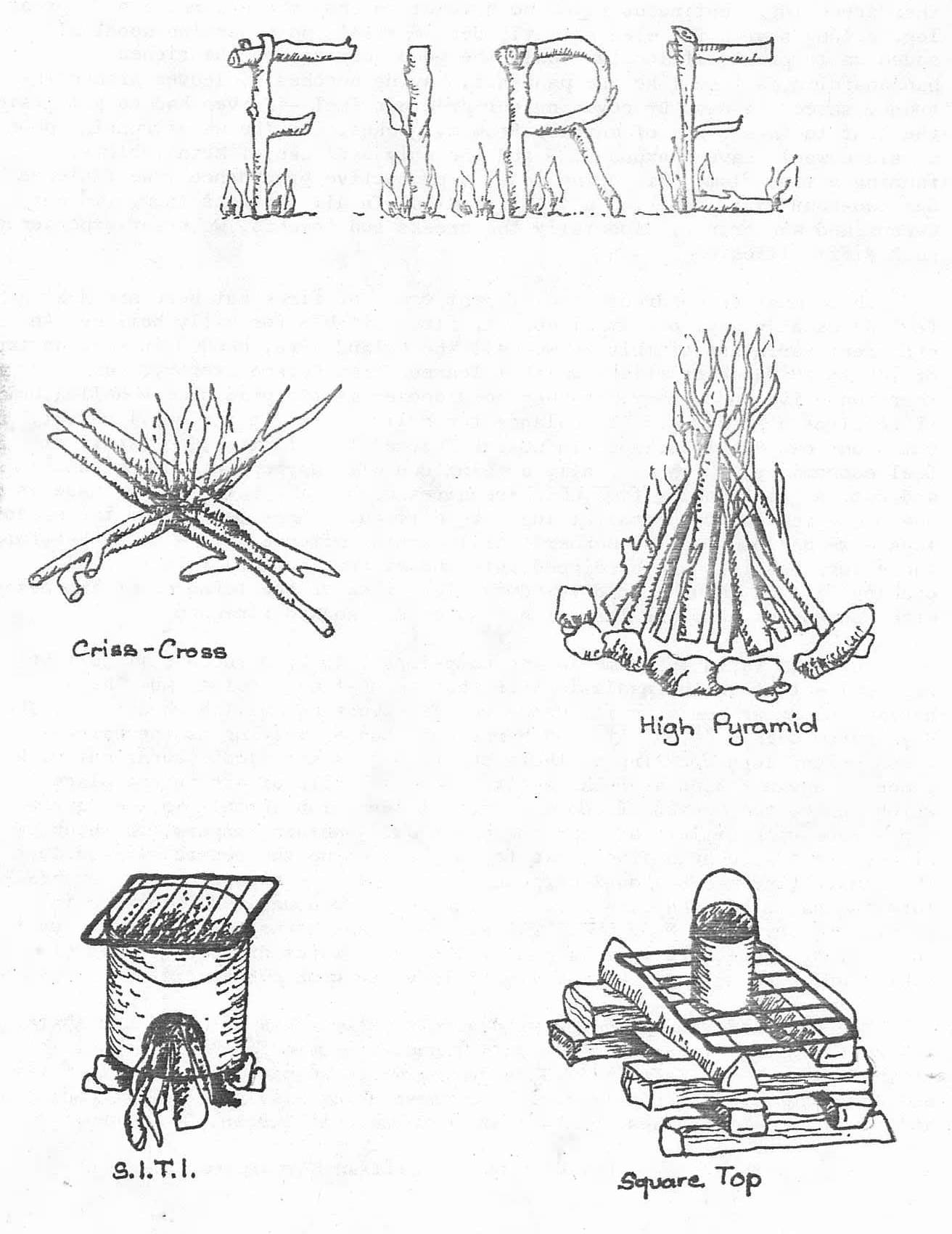
HERE & THERE.
JIM CAMERON, who was farewelled at a dinner on April 1st(good day for it!) as he is off to the U.S.A.,with a possibility of continuing to Europe, for some 9/10 months or thereabouts. Best Wishes,Jim.
JAN BOURNE, went holidaying/working in New Zealand and had the misfortune to break a leg in a motor cycle accident. She returned to Townsville and has hobbled to a few bushwalkers meetings since. Plaster off in April - she might be bushwalking soon.
DAVID BLAIR is now attached to the Department of Zoology at the University of Canterbury, Christchurch, N.Z.
RON NINNIS is nursing the Tasmanians in Hobart up to June or "whenever it gets too cold here". He is we hear seeking a tourism grant for promoting North Queensland down there. Someone, awestruck at a Ron slide of the Herbert Gorge exclaimed "Another Franklin!".
GLENNYS DAVERN has been working in Montrose(Angus,Scotland not Vic.or Tas.) and has, we hear, found a compatible bushwalker(Sorry, hiker) whom she will marry in Townsville this Winter. Best wishes from the Club for future happiness to you both.
RICK WILLIAMS is said to have moored his boat at Orpheus Island and to be acting as Caretaker there for the James Cook University.
Talking of boats, the talented JOHN RILEY says his vessel is very nearly ready (Rick's was that way for ages!) Whether John's is being delayed by his incurcions into the Competitive Ballroom Dancing scene is not recorded but John has been seen as the suave gentleman. M'mm!
ALAN & MARYE SIMET,now in their new Belgian Gardens abode, have been entertaining friends from Switzerland, Rudi & Anne-Marie. The trip up Mt Elliott with Rudi may have been a little bit beyond "entertainment" but they both enjoyed their stay. Since their departure Marye has been brushing up her German - shutting stable doors some might call it.
From Germany we hear that ROLAND GREGORY is alive and well after his visit to Australia last year. We hear of plans to go to Canada whenever Germany finishes.
WOLFGANG KREUTZER has been helping his wife in the field of Scouting recently - leading some good walks too. Has anyone tasted his home-made bread ? A Bushwalker of many talents.
To quote KARMEN NISBET at paytime on the Mount Spec walk " you should be paying us to go on this trip!"
BARBARA WOLFF who was in hospital for a time after the Porcupine Gorge trip is out and about again. Take it easy,Barbara.
And,lastly,LES & LYNN HYLAND are off to Ireland,Britain and Europe at the end of June for seven months. That is one way of relinquishing the Joint Editorial chairs !
